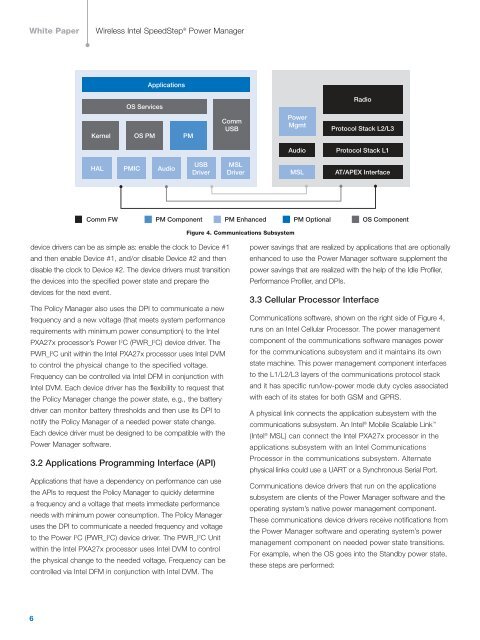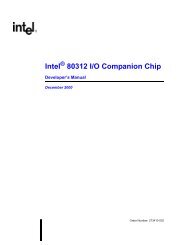Wireless Intel SpeedStep Power Manager
Wireless Intel SpeedStep Power Manager
Wireless Intel SpeedStep Power Manager
Create successful ePaper yourself
Turn your PDF publications into a flip-book with our unique Google optimized e-Paper software.
White Paper<strong>Wireless</strong> <strong>Intel</strong> <strong>SpeedStep</strong> ® <strong>Power</strong> <strong>Manager</strong>ApplicationsOS ServicesRadioKernel OS PM PMCommUSB<strong>Power</strong>MgmtProtocol Stack L2/L3AudioProtocol Stack L1HALPMICAudioUSBDriverMSLDriverMSLAT/APEX InterfaceComm FWPM Component PM Enhanced PM Optional OS ComponentFigure 4. Communications Subsystemdevice drivers can be as simple as: enable the clock to Device #1and then enable Device #1, and/or disable Device #2 and thendisable the clock to Device #2. The device drivers must transitionthe devices into the specified power state and prepare thedevices for the next event.The Policy <strong>Manager</strong> also uses the DPI to communicate a newfrequency and a new voltage (that meets system performancerequirements with minimum power consumption) to the <strong>Intel</strong>PXA27x processor’s <strong>Power</strong> I 2 C (PWR_I 2 C) device driver. ThePWR_I 2 C unit within the <strong>Intel</strong> PXA27x processor uses <strong>Intel</strong> DVMto control the physical change to the specified voltage.Frequency can be controlled via <strong>Intel</strong> DFM in conjunction with<strong>Intel</strong> DVM. Each device driver has the flexibility to request thatthe Policy <strong>Manager</strong> change the power state, e.g., the batterydriver can monitor battery thresholds and then use its DPI tonotify the Policy <strong>Manager</strong> of a needed power state change.Each device driver must be designed to be compatible with the<strong>Power</strong> <strong>Manager</strong> software.3.2 Applications Programming Interface (API)Applications that have a dependency on performance can usethe APIs to request the Policy <strong>Manager</strong> to quickly determinea frequency and a voltage that meets immediate performanceneeds with minimum power consumption. The Policy <strong>Manager</strong>uses the DPI to communicate a needed frequency and voltageto the <strong>Power</strong> I 2 C (PWR_I 2 C) device driver. The PWR_I 2 C Unitwithin the <strong>Intel</strong> PXA27x processor uses <strong>Intel</strong> DVM to controlthe physical change to the needed voltage. Frequency can becontrolled via <strong>Intel</strong> DFM in conjunction with <strong>Intel</strong> DVM. Thepower savings that are realized by applications that are optionallyenhanced to use the <strong>Power</strong> <strong>Manager</strong> software supplement thepower savings that are realized with the help of the Idle Profiler,Performance Profiler, and DPIs.3.3 Cellular Processor InterfaceCommunications software, shown on the right side of Figure 4,runs on an <strong>Intel</strong> Cellular Processor. The power managementcomponent of the communications software manages powerfor the communications subsystem and it maintains its ownstate machine. This power management component interfacesto the L1/L2/L3 layers of the communications protocol stackand it has specific run/low-power mode duty cycles associatedwith each of its states for both GSM and GPRS.A physical link connects the application subsystem with thecommunications subsystem. An <strong>Intel</strong> ® Mobile Scalable Link (<strong>Intel</strong> ® MSL) can connect the <strong>Intel</strong> PXA27x processor in theapplications subsystem with an <strong>Intel</strong> CommunicationsProcessor in the communications subsystem. Alternatephysical links could use a UART or a Synchronous Serial Port.Communications device drivers that run on the applicationssubsystem are clients of the <strong>Power</strong> <strong>Manager</strong> software and theoperating system’s native power management component.These communications device drivers receive notifications fromthe <strong>Power</strong> <strong>Manager</strong> software and operating system’s powermanagement component on needed power state transitions.For example, when the OS goes into the Standby power state,these steps are performed:6
















